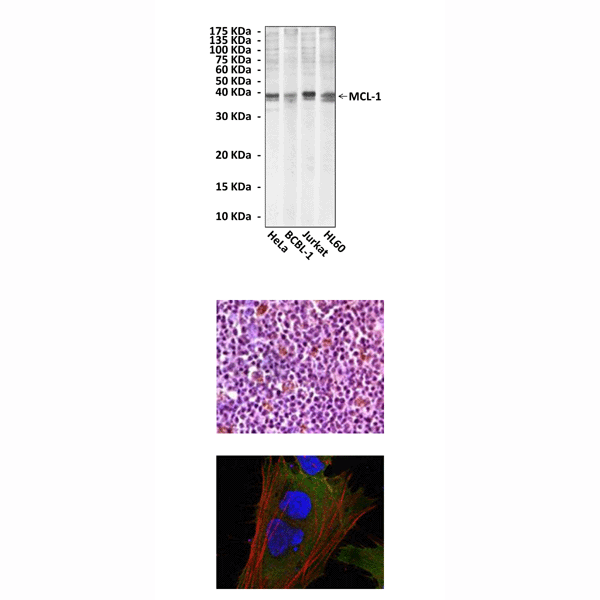Anti-MCL-1: Mouse Myeloid Cell Leukemia-1 Antibody |
 |
BACKGROUND MCL-1 (Myeloid Cell Leukemia-1) was identified in a screen for differentiation-induced genes activated in the human monocytic leukemia cell line, ML-1. The MCL-1 protein is a member of the BCL-2 family displaying all four of the BCL-2 homology domains (BH1–4) and has been localized to intracellular membranes, particularly the mitochondrial membrane. Unlike other members of this protein family, Mcl-1 has an extended N-terminal domain which is rich in PEST sequences. The PEST sequence is probably responsible for the short half-life of this protein MCL-1 is widely expressed in human and murine tissues and cell lines as well as in a wide variety of human tumors. MCL-1 has been shown to delay cell death in selected cell lines, but in comparison, is not as potent as BCL-2, and has no effect in other systems in which BCL-2 proves protective. Transgenic mice that over-expressed Mcl-1 displayed improved hematopoietic cell survival and enhanced outgrowth of myeloid cell lines. MCL-1 knockout mice data indicate that MCL-1 is essential for preimplantation development and implantation.1 Thus, MCL-1 functions to inhibit apoptosis in selected cell types and It could possess other nonapoptotic functions. The anti-apopotic effects of MCL-1 can be regulated by different signaling pathways. MCL-1 was phosphorylated by GSK-3 at a conserved GSK-3 phosphorylation site (S159). S159 phosphorylation of MCL-1 was induced by IL-3 withdrawal or PI3K inhibition and prevented by AKT or inhibition of GSK-3, and it led to increased ubiquitinylation and degradation of MCL-1. Thus, control of MCL-1 stability by GSK-3 is an important mechanism for the regulation of apoptosis by growth factors, PI3K, and AKT.2
MCL-1 expression has been noted to be rapidly up-regulated in response to certain cytotoxic and differentiation stimuli, but the increased expression is often transient. MCL-1 expression was activated by GM-CSF and IL-3 stimulation. Stimulation of mcl-1 gene transcription was mediated through both the PI3-K/Akt-dependent and -independent pathways. And CREB was one component of the transcription factor complex activated by the PI3-K/Akt-dependent pathway and played a role in IL-3 stimulation of mcl-1 gene expression.3 In addition, it was demonstrated that t the JAK / STAT pathway but not of the Ras / mitogen-activated protein (MAP) kinase pathway was involved in IL-6-induced Mcl-1 up-regulation.4
REFERENCES
1. Rinkenberge, J. et al: Gene Dev. 14:23-27, 2000
2. Maurer, U. et al: Mol. Cell 21:749-60, 2006
3. Wang, J.-M. et al: Mol. Cell. Biol. 19:6195-206, 1999
4. Puthier, D. et al: Eur. J. Immunol. 29:3945-50, 1999
2. Maurer, U. et al: Mol. Cell 21:749-60, 2006
3. Wang, J.-M. et al: Mol. Cell. Biol. 19:6195-206, 1999
4. Puthier, D. et al: Eur. J. Immunol. 29:3945-50, 1999
Products are for research use only. They are not intended for human, animal, or diagnostic applications.
Параметры
Cat.No.: | CP10166 |
Antigen: | Purified recombinant human MCL-1 fragments expressed in E. coli. |
Isotype: | Mouse IgG1 |
Species & predicted species cross- reactivity ( ): | Human, Mouse |
Applications & Suggested starting dilutions:* | WB 1:1000 IP 1:50 IHC 1:200 ICC 1:200 FACS n/d |
Predicted Molecular Weight of protein: | 37 kDa |
Specificity/Sensitivity: | Detects endogenous MCL-1 proteins without cross-reactivity with other family members. |
Storage: | Store at -20°C, 4°C for frequent use. Avoid repeated freeze-thaw cycles. |
*Optimal working dilutions must be determined by end user.
Документы
Информация представлена исключительно в ознакомительных целях и ни при каких условиях не является публичной офертой








